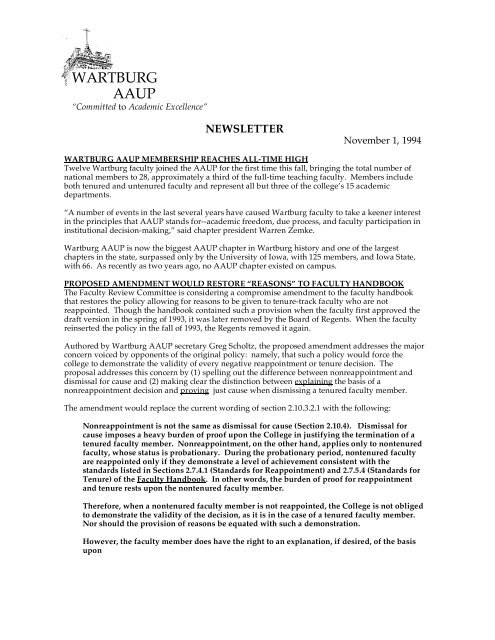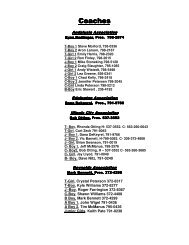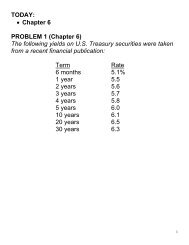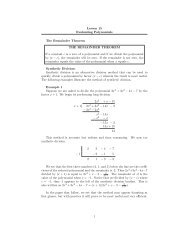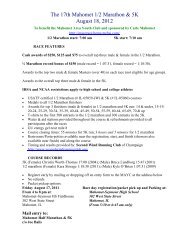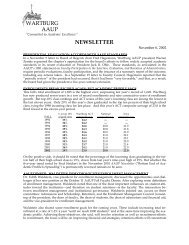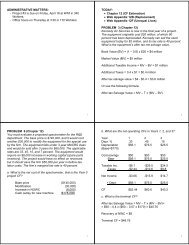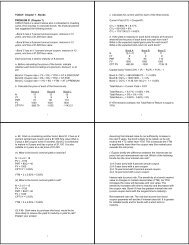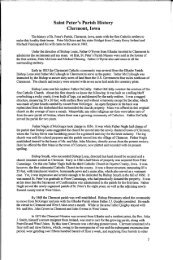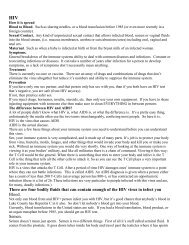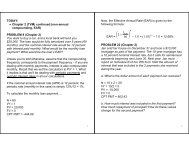WARTBURG AAUP
WARTBURG AAUP
WARTBURG AAUP
Create successful ePaper yourself
Turn your PDF publications into a flip-book with our unique Google optimized e-Paper software.
<strong>WARTBURG</strong><br />
<strong>AAUP</strong><br />
“Committed to Academic Excellence”<br />
NEWSLETTER<br />
November 1, 1994<br />
<strong>WARTBURG</strong> <strong>AAUP</strong> MEMBERSHIP REACHES ALL-TIME HIGH<br />
Twelve Wartburg faculty joined the <strong>AAUP</strong> for the first time this fall, bringing the total number of<br />
national members to 28, approximately a third of the full-time teaching faculty. Members include<br />
both tenured and untenured faculty and represent all but three of the college’s 15 academic<br />
departments.<br />
“A number of events in the last several years have caused Wartburg faculty to take a keener interest<br />
in the principles that <strong>AAUP</strong> stands for--academic freedom, due process, and faculty participation in<br />
institutional decision-making,” said chapter president Warren Zemke.<br />
Wartburg <strong>AAUP</strong> is now the biggest <strong>AAUP</strong> chapter in Wartburg history and one of the largest<br />
chapters in the state, surpassed only by the University of Iowa, with 125 members, and Iowa State,<br />
with 66. As recently as two years ago, no <strong>AAUP</strong> chapter existed on campus.<br />
PROPOSED AMENDMENT WOULD RESTORE “REASONS” TO FACULTY HANDBOOK<br />
The Faculty Review Committee is considering a compromise amendment to the faculty handbook<br />
that restores the policy allowing for reasons to be given to tenure-track faculty who are not<br />
reappointed. Though the handbook contained such a provision when the faculty first approved the<br />
draft version in the spring of 1993, it was later removed by the Board of Regents. When the faculty<br />
reinserted the policy in the fall of 1993, the Regents removed it again.<br />
Authored by Wartburg <strong>AAUP</strong> secretary Greg Scholtz, the proposed amendment addresses the major<br />
concern voiced by opponents of the original policy: namely, that such a policy would force the<br />
college to demonstrate the validity of every negative reappointment or tenure decision. The<br />
proposal addresses this concern by (1) spelling out the difference between nonreappointment and<br />
dismissal for cause and (2) making clear the distinction between explaining the basis of a<br />
nonreappointment decision and proving just cause when dismissing a tenured faculty member.<br />
The amendment would replace the current wording of section 2.10.3.2.1 with the following:<br />
Nonreappointment is not the same as dismissal for cause (Section 2.10.4). Dismissal for<br />
cause imposes a heavy burden of proof upon the College in justifying the termination of a<br />
tenured faculty member. Nonreappointment, on the other hand, applies only to nontenured<br />
faculty, whose status is probationary. During the probationary period, nontenured faculty<br />
are reappointed only if they demonstrate a level of achievement consistent with the<br />
standards listed in Sections 2.7.4.1 (Standards for Reappointment) and 2.7.5.4 (Standards for<br />
Tenure) of the Faculty Handbook. In other words, the burden of proof for reappointment<br />
and tenure rests upon the nontenured faculty member.<br />
Therefore, when a nontenured faculty member is not reappointed, the College is not obliged<br />
to demonstrate the validity of the decision, as it is in the case of a tenured faculty member.<br />
Nor should the provision of reasons be equated with such a demonstration.<br />
However, the faculty member does have the right to an explanation, if desired, of the basis<br />
upon
<strong>AAUP</strong> Newsletter, November 1994, page 2<br />
which the decision was reached. Thus, a faculty member who is not reappointed shall be<br />
advised, upon request, of the reasons which contributed to the nonreappointment decision.<br />
And, if the faculty member so requests, those reasons shall be confirmed in writing.<br />
The rationale for the amendment emphasizes the benefits to the college:<br />
1. To Make Clarification Possible<br />
When providing reasons, the college can clarify the criteria upon which the<br />
nonreappointment or tenure decision was based and thus indicate the appropriateness of its<br />
action.<br />
2. To Reduce the Number of Challenges to Nonreappointment Decisions<br />
Faculty will tend to accept a decision when an explanation is given, especially when that<br />
decision is the outcome of the yearly evaluation process now in place. However, when<br />
reasons are withheld, faculty are more likely to presume that the decision was made on an<br />
inappropriate basis and, consequently, that an appeal or lawsuit will be successful.<br />
3. To Make Correction Possible<br />
Openness about the basis for a nonreappointment decision can furnish the faculty member<br />
with an opportunity to correct any erroneous information that might have been introduced,<br />
however innocently, into the process.<br />
4. To Comply with Widely Accepted Professional Standards<br />
According to Jordan Kurland, associate general secretary of the <strong>AAUP</strong>, more than 90% of<br />
American colleges and universities (nearly 3,000 institutions) now have a policy of giving<br />
reasons to faculty who receive negative reappointment or tenure decisions.<br />
In Iowa, at least 29 institutions provide reasons, upon request, to faculty who are not<br />
reappointed. Of the 29 ELCA colleges, only six do not follow such a policy.<br />
Proponents of this amendment believe that providing reasons to tenure-track faculty who are not<br />
reappointed not only serves the long-term best interests of Wartburg College but demonstrates a<br />
commitment to fairness and decency consistent with our identity as a college of the church.<br />
SUSAN VALLEM DEMYSTIFIES DEPARTMENTAL ASSESSMENT<br />
The draft of the Wartburg College Educational Outcomes Assessment Plan, reviewed during faculty<br />
workshop, provided an excellent picture of where we have been. And the sample program goals<br />
were also very helpful. What follows are some practical suggestions on how to implement that plan<br />
on the departmental level.<br />
Developing goals is a critical first step. Goals represent envisioned aims toward which cognitive,<br />
emotional, behavioral, and situational actions are directed. As the title of a popular book by David<br />
Campbell suggests, If You Don’t Know Where You’re Going, You’ll End Up Somewhere Else (1974).<br />
The Wartburg <strong>AAUP</strong> Newsletter is<br />
published monthly during the<br />
academic year. Members of the<br />
editorial staff include Warren<br />
Zemke, Moira McCluney, Susan<br />
Vallem, and Greg Scholtz. Signed<br />
submissions from members and<br />
non-members are welcome, though<br />
the editors reserve the right to edit<br />
for length.<br />
Effective goals are (1) described as accomplishments rather<br />
than processes, (2) clear and specific, (3) stated in verifiable<br />
terms, (4) realistic, and (5) congruent with college and<br />
department statements.<br />
Departmental goals thus need to flow from the College’s<br />
mission statement and academic vision while reflecting the<br />
department’s mission. The easiest way to attain congruency<br />
is to use some of the same language, e.g., “service,”<br />
“leadership,” “ethics,” “participation,” etc.
<strong>AAUP</strong> Newsletter, November 1994, page 3<br />
Verifying or measuring goals (although goals are not always precisely measurable) does not<br />
necessarily require elaborate research designs. You probably have many measures already in place.<br />
Examples include regular examinations, student papers and presentations, student evaluations of<br />
courses and instructors, employment and graduate school admission rates, student research projects,<br />
pre- and post-tests, alumni surveys, practicum and internship supervisor evaluations of students,<br />
and outside evaluations of student work or performance. Since faculty have the credentials to make<br />
professional judgements, faculty evaluation of students and program outcomes is also acceptable.<br />
All of these activities should be worded in a way that is congruent with the departmental goals.<br />
Additional measures include faculty development activities, professional activities, community and<br />
campus involvement, advising, networking, and assistance in finding employment. For example,<br />
are most of your students graduating in four years and successfully finding employment or<br />
pursuing graduate study in their fields? Again, terminology congruent with the goals should be<br />
used.<br />
Boiled down to essentials, writing an assessment plan is simple: Name your goals, describe how<br />
you have been successfully meeting them, state how you know when the goals are met, and list<br />
areas for continued growth and development. Many have found this format useful: “Students will<br />
(goal) ,which will be demonstrated by (verification) .”<br />
--Susan Vallem<br />
IS YOUR DEPARTMENT ABOVE AVERAGE?<br />
Grade Point Averages 1993-94 by Academic Area<br />
(The Wartburg average is 3.121 )<br />
3.841 RC 3.391 HE 3.143 ART 2.926 PSY<br />
3.810 LS 3.333 FL 3.132 EN 2.916 HI<br />
3.796 IC 3.332 PHY 3.114 PH 2.875 PS<br />
3.743 FR 3.263 CA 3.056 ID 2.819 BI<br />
3.693 GER 3.244 RE 3.053 BA 2.781 CH<br />
3.582 ED 3.191 SW 2.967 FS 2.745 MA<br />
3.439 SP 3.186 AC 2.962 SO 2.700 WS<br />
3.408 MU 3.173 CS 2.954 PE 2.522 EC<br />
CHAPTER CHOOSES NEW TREASURER<br />
At its October meeting, Wartburg <strong>AAUP</strong> elected Susan Vallem chapter treasurer, filling the vacancy<br />
left by Heimir Geirsson when he resigned this summer to join the philosophy department at<br />
Grinnell. Vallem is chair of the Department of Social Work.<br />
HEIMIR GEIRSSON APPOINTED TO IOWA COMMITTEE A<br />
Iowa <strong>AAUP</strong> president Mearl Kilmore has announced the appointment of former Wartburg<br />
philosophy professor Heimir Geirsson to the Iowa Conference Committee A. Members of Iowa<br />
Committee A offer assistance in matters of academic freedom and due process to any Iowa faculty<br />
who request it, regardless of whether or not they are members of <strong>AAUP</strong>. (Wartburg professor Greg<br />
Scholtz also serves on Committee A.)<br />
“I am happy to have the opportunity to help colleagues in trouble,” said Geirsson. “Perhaps in this<br />
way I can put last year’s experience to a useful purpose.” Geirsson, who now teaches ethics at<br />
Grinnell, left Wartburg last year after his tenure-track position was eliminated because of a lack of<br />
“institutional need,” his appeal of that decision having been unsuccessful.<br />
<strong>AAUP</strong> TO DISCUSS FACULTY SALARIES<br />
Wartburg <strong>AAUP</strong> meets 7:30-8:30 p.m., Thursday, November 10, in the Conference Room of the<br />
Student Union to talk about faculty salaries. After a discussion of salary comparisons, the chapter<br />
will make its annual recommendation on raises to the Budget and Building Committee. All faculty<br />
are welcome.
<strong>AAUP</strong> Newsletter, November 1994, page 4<br />
COLLEGE RANKINGS: HOW DO WE STACK UP AGAINST THE COMPETITION?<br />
The September 17 U.S. News and World Report ranked Wartburg in the 4th tier (the 121st to 160th) of<br />
the 164 “national liberal arts colleges,” institutions that award more than 40% of their degrees in the<br />
liberal arts.<br />
Rankings were based on six attributes: reputation, selectivity, faculty resources, financial resources,<br />
graduation rate, and alumni satisfaction, weighted most heavily by faculty resources (20%) and<br />
reputation and student selectivity (25% each).<br />
The table below compares Wartburg with its chief competitors among Iowa and ELCA colleges. All<br />
data are from the U.S. News article, except 1993-94 tuition and fees. (Peer institutions which failed to<br />
make the rankings were Buena Vista, Simpson, and Augsburg. Augustana-Sioux Falls was listed<br />
with the top 10 midwestern “regional liberal arts colleges,” a category reserved for schools awarding<br />
less than 40% of their degrees in the liberal arts.)<br />
Avg. Frosh Fac 1 Student/ Total 2 Alum 3 Grad 4 Academic 1993-94 5<br />
SAT/ in top Accept with Faculty Expenditure Giving Rate Reputation Tuition<br />
ACT 10% Rate Ph.D Ratio per FTE Rate (6 yr.) (ranking) & Fees<br />
Augustana (IL) 26 36% 88% 83% 13/1 $9,220 40% 68% 109 $12,942<br />
Central 24 31 87 90 14/1 8,444 29 65 124 $10,365<br />
Coe 1045 29 74 86 13/1 10,141 32 65 99 $12,805<br />
Concordia (MN) 910 30 90 69 13/1 8,129 46 66 129 $9,700<br />
Cornell 1080 33 86 76 12/1 10,340 31 62 68 $14,228<br />
Grinnell 1265 56 68 92 10/1 18,979 54 80 10 $15,404<br />
Gustavus 1110 36 81 89 13/1 9,907 58 77 68 $13,435<br />
Luther 1110 38 90 85 14/1 8,949 38 74 99 $12,375<br />
St. Olaf 1110 38 74 88 10/1 12,502 31 80 36 $13,560<br />
Wartburg 1045 34 87 91 12/1 7,735 37 64 129 $11,080<br />
Notes: (1) Includes faculty with terminal degrees. (2) The total expenditure per full-time-equivalent student is<br />
the amount the institution spent during AY 1993-94 for instruction, student services, administration, and<br />
academic support, including libraries and computers. (3) Represents the average percentage of living alumni<br />
who donated to their alma maters’ fund drives during 1992 and/or 1993. (4) The average percentage of<br />
freshmen enrolled in 1984-87 who graduated in six years. (5) From the October 5 Chronicle of Higher Education.<br />
While Wartburg compares favorably in several categories, it is clear that two areas will require<br />
attention if the college is to remain competitive: (1) Wartburg must continue to strive to be more<br />
selective in student recruitment, a strategy which should improve retention and enhance<br />
academic reputation, and (2) although faculty quality and student-faculty ratio are strong, Wartburg<br />
needs to increase its expenditures per FTE (e.g., on faculty salaries, library support, etc.).<br />
FROSH A.C.T. AND CLASS RANK HIGHEST EVER<br />
The average ACT composite score for the Class of 1999 is 24.6, about the 80th percentile nationally<br />
and an all-time high at Wartburg. (The national average this year is 20.8; the Iowa average 21.9.)<br />
In addition, a record 42% of this year’s freshmen graduated in the top 10% of their high school class,<br />
up from 34% last year.<br />
It is not surprising that, with the academic profile rising steadily over the last three years, retention<br />
has also improved: 85.8% of last year’s students returned to Wartburg this fall (another record).<br />
The Department of Admissions is to be commended for its efforts to recruit students whose<br />
academic preparation improves their chances for success at Wartburg College.


